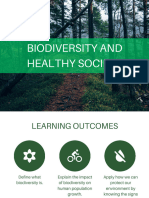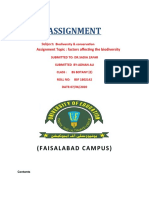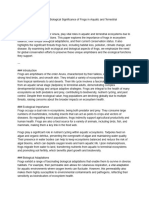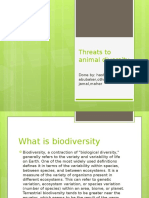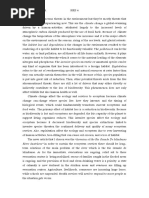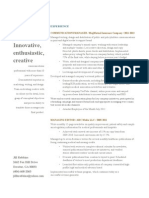PDF Biodiversity
PDF Biodiversity
Uploaded by
Savita SinghCopyright:
Available Formats
PDF Biodiversity
PDF Biodiversity
Uploaded by
Savita SinghOriginal Description:
Copyright
Available Formats
Share this document
Did you find this document useful?
Is this content inappropriate?
Copyright:
Available Formats
PDF Biodiversity
PDF Biodiversity
Uploaded by
Savita SinghCopyright:
Available Formats
Home / Life / Biodiversity
Loss of biodiversity
Causes of the loss of biodiversity
The main cause of the loss of biodiversity can be attributed to the influence of human beings on the world’s ecosystem,
In fact human beings have deeply altered the environment, and have modified the territory, exploiting the species directly,
for example by fishing and hunting, changing the biogeochemical cycles and transferring species from one area to
another of the Planet.
The threats to biodiversity can be summarized in the following main points:
1. Alteration and loss of the habitats: the transformation of the natural areas determines not only the loss of the
vegetable species, but also a decrease in the animal species associated to them. Refer to “Alteration and loss
of the habitats”.
2. Introduction of exotic species and genetically modified organisms; species originating from a particular
area, introduced into new natural environments can lead to different forms of imbalance in the ecological
equilibrium. Refer to, “Introduction of exotic species and genetically modified organisms”.
3. Pollution: human activity influences the natural environment producing negative, direct or indirect, effects that
alter the flow of energy, the chemical and physical constitution of the environment and abundance of the
species;
4. Climate change: for example, heating of the Earth’s surface affects biodiversity because it endangers all the
species that adapted to the cold due to the latitude (the Polar species) or the altitude (mountain species).
5. Overexploitation of resources: when the activities connected with capturing and harvesting (hunting, fishing,
farming) a renewable natural resource in a particular area is excessively intense, the resource itself may
become exhausted, as for example, is the case of sardines, herrings, cod, tuna and many other species that
man captures without leaving enough time for the organisms to reproduce.
Changes in and loss of habitats
One of the greatest threats for the survival of the species are the changes, loss and fragmentation of their habitat.
Human beings, in fact, have deeply modified the territory, as a result of a large growth in the population, industrial
development, the expansion of transportation networks, and agriculture and fishing on an industrial scale. An example of
the consequences of the changes in the habitats can be seen In the Mediterranean Sea. Posidonia oceanica is an
endemic marine plant in the Mediterranean that forms submerged sea grass meadows on the sandy bottom, which are a
fundamental component of the equilibrium and of the richness of the sea coast environment. This plant has a great
environmental value, in fact, one square metre of sea grass meadow can produce 10 to 15 litres of oxygen per day.
Furthermore the meadows give shelter to a great variability of biological species, both vegetable and animal, (400
vegetable species and approximately 1000 animal species), in fact many animals find food and shelter there. Another
important function carried out by Posidonia is to protect the sea coast, where it guarantees stability, acting as a protection
from sea currents and the waves. It has been calculated that a regression of only one metre of the sea grass meadows
can lead to a loss of about 15-18 metres of sandy coastline. Among the principal causes of danger for the Posidonia sea
grass meadows is the fishing activity with bottom trawling nets that tear away the plants leaving the subsoil uncovered;
and subsequent recolonization of these plants becomes difficult. If the meadows disappear, the principal effects will be: a
loss of biodiversity, a change in the trophic network, a decrease in productivity with consequent damage to fishing itself,
a change in the metabolizing process of trophic chains, an increase in coastal erosion, and the consequent decrease in
the quality of the environment.
During the last century, changes in the territory consisted mainly of an increase in the surface area taken by agriculture
and livestock farming, an increase in the urban areas, the development of road networks and the related infrastructures,
Home / Life / Biodiversity
the construction of hydroelectric plants and hydraulic plants, exploitation of underground deposits and fishing with more
powerful boats and more efficient nets. Due to these changes, the natural environments are changed, destroyed and
subdivided, which cause the loss, and division into small parts, of the habitats. The importance of the loss of the habitats
is surely intuitive, while the concept of “fragmentation” is more difficult to understand. Fragmentation of the habitat is a
division of the territory into various smaller areas that can remain, in some way connected to each other or may be totally
isolated. The consequence of this leads to the subdivision of populations distributed in that particular area which are,
therefore, less consistent than the original population. For this reason populations become more vulnerable to external
stress, to climatic changes, to anthropic disturbance, epidemics and genetic deterioration due to cross- breeding among
the population that is “related”.
For example, it is calculated that every year approximately one million specimens of amphibians in the region of
Lombardy, are affected by car traffic. In particular, the species that are most affected by this problem are the green frogs
(Rana kl. esculenta) and the common toads (Bufo bufo). When these animals move toward the reproduction areas, they
are forced to cross a number of asphalted roads that are often found around the waterways in Lombardy. Therefore the
adult breeder specimens face mass extermination due to their slow and clumsy movement at dusk or during the night
hours, before they have laid their eggs. It has been shown that the impact of roads can cause the extinction of these
populations of amphibians.
Introduction of exotic species and genetically modified organisms (GMO)
Often a very important factor is neglected, which is the introduction of allochthonous species, i.e. species whose origin is
in other geographic areas and that therefore have not adapted, through the long natural selection processes, to the new
environment in which they are introduced.
It has been calculated that approximately 20% of the cases of extinction of birds and mammals is due to the direct action
of animals introduced by man. The reason for this extinction can be attributed to various causes: to competition for
limited resources, to predation by the “new” species, to the diffusion of new diseases and to the damages that the
species that have been introduced can cause to the natural vegetation, to the cultivations and to zootechnics. An
example of the problem in Europe is seen in the introduction of the grey squirrel (Sciurus carolinensis) imported from
North America, that is replacing the red European squirrels (Sciurus vulgaris). Also the red eared slider (Trachemis
scripta elegans) was imported into Italy from the United States as a pet animal, but when people started to free them in
the ponds (because they became too big) this triggered a competitive mechanism between the American slider and the
European pond turtle (Emys orbicularis).
Another problem that causes the loss of biodiversity is to be attributed to the introduction in the environment of
genetically modified organisms (GMO) that are also known as transgenic organisms. A GMO is an organism, in whose
chromosomes a foreign gene, taken from an organism of a different species, is inserted with genetic engineering
techniques. In this way it is possible to create a new organism with particular desired characteristics: for example some
organisms of the vegetable kingdom may become more resistant to herbicides or harmful insects; some livestock
animals become more productive or more resistant to infections. With regard to the potential harmfulness of the GMO
there is a violent debate between those who believe that the advantages for medicine and for society are greater than
the possible effects on the environment, and those who state that too little is known to be able to use them, and that the
environment will feel the effect of the genetic pollution of the natural species with numerous consequences: the
involuntary transmission of resistance to herbicides in infesting plants, the evolution of more resistant parasites, the
increased use of herbicides, the disappearance of species of insects and as a consequence the loss of biodiversity.
Examples of GMO are to be found in two particular plants: maize and soya. In maize, resistance to harmful insects is
obtained by introducing the Bt gene of the Bacillus thuringiensis bacterium. This bacterium, that lives in the soil,
produces a protein that becomes toxic only in the insect’s intestine, and causes its death. The protein is not toxic for
humans nor for other animals, in fact, before the invention of these sophisticated techniques in genetic engineering, it
was used as a natural insecticide, particularly in Canada to protect the forests from insect attacks. This technology, for
the maize plants, leads to a decrease in the harmful insects and contamination by bacteria, virus and fungi, that can
produce mycotoxins that are carcinogenic. The above technique is applied to soya in order to make it more resistant to
Home / Life / Biodiversity
herbicides; in particular to glyphosate and glyphosinate, that are biodegradable herbicides that are harmless for man and
animals, but can kill all the plants. In this way it is possible to eradicate all the infesting plants without the need for further
treatments with products that are extremely harmful for man and the environment.
You might also like
- Workbook+for+Mindful+Self DisciplineDocument60 pagesWorkbook+for+Mindful+Self DisciplineLeonardo Mier100% (2)
- The Testament: by John GrishamDocument5 pagesThe Testament: by John GrishamAlicia VirolaNo ratings yet
- Threats To BiodiversityDocument27 pagesThreats To BiodiversityHaritha BhimavarapuNo ratings yet
- Human Activities and Their Impacts On BiodiversityDocument33 pagesHuman Activities and Their Impacts On Biodiversitybutterfily75% (4)
- Brosur ICAsolar Inverter On Grid SNV-GT 2016Document2 pagesBrosur ICAsolar Inverter On Grid SNV-GT 2016karidhoNo ratings yet
- Threats To BiodiversityDocument7 pagesThreats To BiodiversityHarsh Vardhan Singh100% (1)
- Lecture 9 - B4501-Advanced Ecology-2024-2025Document7 pagesLecture 9 - B4501-Advanced Ecology-2024-2025Khauhelo bernard LechesaNo ratings yet
- The Paper Factors That Cause Biodiversity DegradationDocument15 pagesThe Paper Factors That Cause Biodiversity DegradationRagat PratamaNo ratings yet
- Lecture 3Document4 pagesLecture 3seemaqayyum066No ratings yet
- Biodiversity Loss 1Document28 pagesBiodiversity Loss 1pca007815No ratings yet
- Anthropogenic Causes of Extinction: By:Ranya Mae Baga-An and Jessica Joy H. AumentadoDocument9 pagesAnthropogenic Causes of Extinction: By:Ranya Mae Baga-An and Jessica Joy H. AumentadoSarah GanganNo ratings yet
- Hand_outs_AiShie (1)Document2 pagesHand_outs_AiShie (1)hariesanraqNo ratings yet
- Threats To BiodiversityDocument5 pagesThreats To BiodiversityVICKY MAHTO50% (2)
- Biodiversity and Conservation PDFDocument24 pagesBiodiversity and Conservation PDFPayal ShokeenNo ratings yet
- BiodiversityDocument4 pagesBiodiversityanaisha.bhutani2010No ratings yet
- Biodiversity Healthy SocietyDocument35 pagesBiodiversity Healthy Societyxirbcia0308No ratings yet
- Chapter-6-BiodiversityDocument8 pagesChapter-6-Biodiversityannrose0717No ratings yet
- Biodiversity and The Healthy SocietyDocument5 pagesBiodiversity and The Healthy SocietyMichelle AlvarezNo ratings yet
- Group 11 - DESTRUCTION OF BIOTADocument79 pagesGroup 11 - DESTRUCTION OF BIOTAJc MatrianoNo ratings yet
- Causes of ExtinctionDocument6 pagesCauses of ExtinctionpatrickkayeNo ratings yet
- BEEd 2A Biodiversity Evolution 1Document8 pagesBEEd 2A Biodiversity Evolution 1razzelngpinasNo ratings yet
- The Extinction of Animals, JANETHDocument4 pagesThe Extinction of Animals, JANETHJaneth VelázquezNo ratings yet
- Major Threats To BiodiversityDocument10 pagesMajor Threats To BiodiversityCibi MNo ratings yet
- EVS AssignmentDocument12 pagesEVS Assignmentvarun singhNo ratings yet
- BIODIVERSITYDocument29 pagesBIODIVERSITYDominic H. LarayNo ratings yet
- Biodiversity ConventionDocument31 pagesBiodiversity Conventionaarzoo dadwalNo ratings yet
- Define Biodiversity, Sustainability, Habitat, Biotic Ecosystem and Abiotic EcosystemDocument4 pagesDefine Biodiversity, Sustainability, Habitat, Biotic Ecosystem and Abiotic EcosystemVanessaNo ratings yet
- ACFrOgBAUmncsiTBfJgzKRtjrMIPYF0ysWtg2cBrdbchftsJSBjES TIsp0kii0UphRwoPJn7hu2b IMACm62mu6LGJ MTqd7 65Av4wHIDb8BWCAkCR7x1 ZTxBexjVodQEcD2YE9kAZFtTuYoiX5XUuCh52iYpL9l0hQVGBw==Document31 pagesACFrOgBAUmncsiTBfJgzKRtjrMIPYF0ysWtg2cBrdbchftsJSBjES TIsp0kii0UphRwoPJn7hu2b IMACm62mu6LGJ MTqd7 65Av4wHIDb8BWCAkCR7x1 ZTxBexjVodQEcD2YE9kAZFtTuYoiX5XUuCh52iYpL9l0hQVGBw==nibbanumberoneNo ratings yet
- Rimjhim23583080EVS (1)Document7 pagesRimjhim23583080EVS (1)rimjhim283No ratings yet
- Chapter 3Document55 pagesChapter 3huziikoo38No ratings yet
- Frog ExctinctionDocument12 pagesFrog ExctinctionLeonardo SouzaNo ratings yet
- NDocument4 pagesNRhyian ArmaNo ratings yet
- Lesson 7 Species ExtinctionDocument38 pagesLesson 7 Species ExtinctionpreianhajaneNo ratings yet
- AhhhhhhhhhhhhhhhhhhhhhhhDocument4 pagesAhhhhhhhhhhhhhhhhhhhhhhhJohn Calvin GerolaoNo ratings yet
- Causes of Biodiversity LossDocument1 pageCauses of Biodiversity LossJemar WyneNo ratings yet
- Lecture Note Biodiversity ConceptsDocument13 pagesLecture Note Biodiversity ConceptsmariashekinahdNo ratings yet
- GRP-2 BiodiversityDocument7 pagesGRP-2 BiodiversityRonaly HiladoNo ratings yet
- Envsci BiodiversityDocument88 pagesEnvsci BiodiversityAnn Jielyn Ablao ManongNo ratings yet
- STS Biodiversity and Human HealthDocument7 pagesSTS Biodiversity and Human HealthChrista JesusaNo ratings yet
- Department of Zoology: MaricultureDocument21 pagesDepartment of Zoology: Mariculturesaman aslamNo ratings yet
- BiodiversityDocument2 pagesBiodiversityJoshua RodrickNo ratings yet
- Southwestern College of Maritime, Business and Technology, IncDocument4 pagesSouthwestern College of Maritime, Business and Technology, IncJosiel Alcarez MercaderoNo ratings yet
- How Do Species and Communities EvolveDocument5 pagesHow Do Species and Communities EvolveAdrian P. TabanaoNo ratings yet
- Explain How Disturbances Can Benefit Communities. Distinguish Between Primary and Secondary SuccessionDocument3 pagesExplain How Disturbances Can Benefit Communities. Distinguish Between Primary and Secondary SuccessionIssah TubongbanuaNo ratings yet
- BiologyProjectDocument4 pagesBiologyProjectblendinjoNo ratings yet
- Factors Effecting BiodiversityDocument12 pagesFactors Effecting BiodiversityAdnan AliNo ratings yet
- Presentation 1Document30 pagesPresentation 1ceagain5No ratings yet
- Threats - To - Biodiversity - and - Conservation - MethodsDocument40 pagesThreats - To - Biodiversity - and - Conservation - Methodsjosnamary98No ratings yet
- The Ecological and Biological Significance of Frogs in Aquatic and Terrestrial EcosystemsDocument2 pagesThe Ecological and Biological Significance of Frogs in Aquatic and Terrestrial EcosystemsMonkopaz ZebNo ratings yet
- Environmental Issues in Natural Resources ManagementDocument17 pagesEnvironmental Issues in Natural Resources Managementbernicemensahgud1No ratings yet
- 55 LectureOutlineDocument10 pages55 LectureOutlineAlyssa RenéeNo ratings yet
- Threats To Animal DiversityDocument7 pagesThreats To Animal Diversityapi-306057855No ratings yet
- Agriculture and PollutionDocument7 pagesAgriculture and PollutionARC-HI TECTNo ratings yet
- Pollution, Humans, and Global Climate Change) Factors Become The Threat ToDocument2 pagesPollution, Humans, and Global Climate Change) Factors Become The Threat ToLexter CrudaNo ratings yet
- BIODIVERSITYDocument8 pagesBIODIVERSITYahmedakramezaz293No ratings yet
- TGN 404 AssignmentDocument3 pagesTGN 404 AssignmentolimugeorgeogolaNo ratings yet
- Many Think That The Humankind Is in The Midst of An Environmental CrisisDocument4 pagesMany Think That The Humankind Is in The Midst of An Environmental CrisisAkash EkNo ratings yet
- Biodiversity FinalDocument44 pagesBiodiversity FinalMw Waqas89% (9)
- Threats in The EnvironmentDocument1 pageThreats in The EnvironmentJudith LlemitNo ratings yet
- UG SEM 6 C14T Unit-7Document7 pagesUG SEM 6 C14T Unit-7Messi10 BtyNo ratings yet
- Bhavish HIPPCOThreatstoBiodiversityWorksheet-1Document7 pagesBhavish HIPPCOThreatstoBiodiversityWorksheet-1bhavish8678No ratings yet
- Super Species: The Creatures That Will Dominate the PlanetFrom EverandSuper Species: The Creatures That Will Dominate the PlanetRating: 5 out of 5 stars5/5 (1)
- Status Report On Prison Health in The WHO European Region 2022Document504 pagesStatus Report On Prison Health in The WHO European Region 2022silviaNo ratings yet
- 2knowmyself How To Know If Someone Is Lying To YouDocument13 pages2knowmyself How To Know If Someone Is Lying To YouAhmed SkenderNo ratings yet
- Guide To Cleanroom Classifications ISO 8 To ISO 5Document5 pagesGuide To Cleanroom Classifications ISO 8 To ISO 5Siva MNo ratings yet
- Pierburg-Fuel Pump Product Info PDFDocument52 pagesPierburg-Fuel Pump Product Info PDFGauravPradhanNo ratings yet
- Chapter 5Document43 pagesChapter 5Mhiret Bekalu100% (1)
- Abnormal PsychologyDocument9 pagesAbnormal PsychologyHomo CyberneticusNo ratings yet
- Cades Cove Fall 2022 Prescribed Burn MapDocument1 pageCades Cove Fall 2022 Prescribed Burn MapWVLT NewsNo ratings yet
- Paper FullDocument12 pagesPaper FullShashikanth MohrirNo ratings yet
- 11Document6 pages11khaniyalalNo ratings yet
- Handout For Stability of Floating Bodies PresentationDocument3 pagesHandout For Stability of Floating Bodies PresentationGerardoNo ratings yet
- Eskort Recipes PDFDocument24 pagesEskort Recipes PDFLizel Wild50% (2)
- Jill Robbins Resume FinalDocument2 pagesJill Robbins Resume Finalapi-213181366No ratings yet
- BFL5818 MSDSDocument7 pagesBFL5818 MSDSRamdhan ShalehNo ratings yet
- Script Title DefenseDocument3 pagesScript Title DefenseAngel NathalieNo ratings yet
- Sathish Rajamani Milieu TherapyDocument4 pagesSathish Rajamani Milieu TherapySathish Rajamani0% (1)
- Inter 2 Chemistry Companion Series 2021Document17 pagesInter 2 Chemistry Companion Series 2021Team Work 10No ratings yet
- Test Bank For Radiation Protection in Medical Radiography 7th Edition by ShererDocument6 pagesTest Bank For Radiation Protection in Medical Radiography 7th Edition by Shererconalque0nzp9uNo ratings yet
- Chemistry DocumentDocument648 pagesChemistry DocumentbrieNo ratings yet
- 5.antihypertensive DrugsDocument63 pages5.antihypertensive Drugskumbirai Gladys MandavaNo ratings yet
- TQM Customer Satisfaction QuestionsDocument35 pagesTQM Customer Satisfaction QuestionsJagat Singh Dhami100% (2)
- Course Syllabus in PE 101: Movement Enhancement Course Number Course Title Course Credit/Unit: 2 UnitsDocument2 pagesCourse Syllabus in PE 101: Movement Enhancement Course Number Course Title Course Credit/Unit: 2 UnitsKen Iyan C.No ratings yet
- 12 A MouldingDocument35 pages12 A Mouldingshreeghadage7No ratings yet
- 102721.MCRO - 34 CR 20 658 - Order Other - 2020 10 27 - 20210318153105Document3 pages102721.MCRO - 34 CR 20 658 - Order Other - 2020 10 27 - 20210318153105West Central TribuneNo ratings yet
- Electrical Engineering Tech - ResumeDocument2 pagesElectrical Engineering Tech - ResumekandareidNo ratings yet
- Van Jones The Economic InjusticeDocument7 pagesVan Jones The Economic Injusticelila bNo ratings yet
- Use of Alcohol in ProductsDocument15 pagesUse of Alcohol in ProductsCHE WAN MUHAMMAD FAIZ CHE WAN ABDULLAHNo ratings yet
- OWL Tutorial 2ADocument16 pagesOWL Tutorial 2ANatNo ratings yet
























